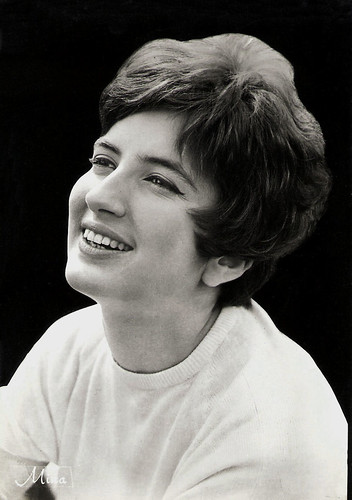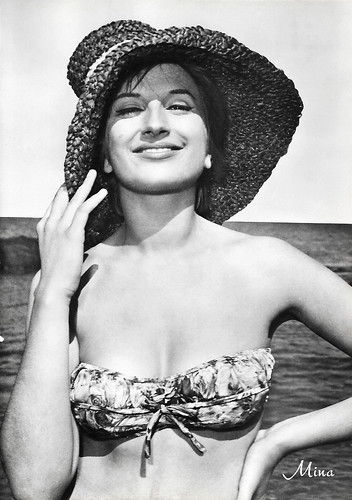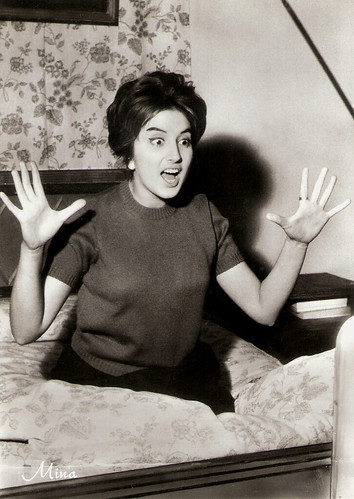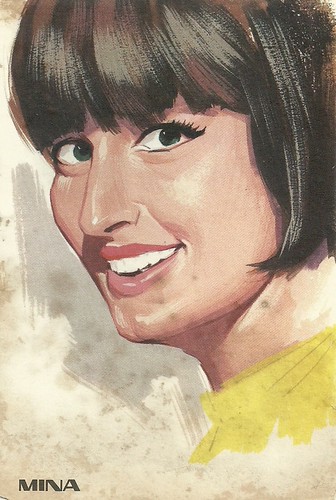Italian singer Mina (1940) dominated the Italian charts for fifteen years and reached an unsurpassed level of popularity in Italy. The ‘Queen of Screamers’ was a staple of Musicarellos, the popular Italian musical comedies of the early 1960s, and Italian television variety shows. During five decades, she had more than 70 singles in the Italian charts.

Italian postcard by Rotalfoto, Milano, no. 867.

Italian postcard by Rotalfoto, Milano, no. 959.

Italian postcard by Rotalfoto, Milano, no. 974.
Mina was born as Anna Maria Mazzini into a working class family in Busto Arsizio, Lombardy in 1940. After finishing secondary school in Cremona, she attended college where she majored in accounting.
She was caught up in the rock and roll wave sweeping across Italy in 1958. Mina listened to American rock and roll and jazz records, and was a frequent visitor of the Derby, the Santa Tecla and the Taverna Messicana clubs of Milan, known for promoting rock and roll.
She started a musical career with the backing of the band Happy Boys. Her repertoire included clumsy imitations of British and American rock and jazz songs, while her extra-loud and syncopated version of the song Nessuno (Nobody) showcased her excellent sense of rhythm. She soon signed with Davide Matalon, owner of the small record company Italdisc.
She introduced her stage name Mina with her first single, Non partir/Malattia. Her performance at the Sei giorni della canzone festival of Milan was described by the La Notte newspaper as the ‘birth of a star’. In 1959, Mina's TV appearances were the first for a female rock and roll singer in Italy and they were a revelation. Her loud syncopated singing earned her the nickname ‘Queen of Screamers’. The public also labelled her the ‘Tiger of Cremona' for shaking her head, hands, and hips wildly to the rhythm.
Her first Italian #1 hit was the surf pop Tintarella di luna (Moon Tan) in September 1959. It was performed in her first Musicarello, Juke box - Urli d'amore/Juke Box - Howls of Love (Mauro Morassi, 1959) with Karin Baal.
In the following year she was seen in the films I Teddy Boys della canzone/The Teddy Boys of Music (Domenico Paolella, 1960), Urlatori alla sbarra/Howling to the bar (Lucio Fulci, 1960) opposite Adriano Celentano, Madri pericolose/Dangerous mothers (Domenico Paolella, 1960) with Ave Ninchi, and Mina... fuori la guardia/Mina... Watch Out! (Armando W. Tamburella, 1961).
In his review of I Teddy Boys della canzone, Tod Kimmell (The Willing Mind) writes at IMDb: “There has never been a film before or since like I Teddy Boys della canzone. Mainly, and blessedly, a vehicle for the incomparable Mina.(...) The big finale field party is almost impossible to watch, and certainly impossible to NOT watch. There are so many disparate sounds and beats fighting for attention, it’s like having delirium tremens... yet incredibly satisfying. I promise that if I ever, EVER, find a copy of this on 16mm, I will show it all over the country, outdoors, for free. Seeing it is a life altering experience that needs to be shared!”.

Italian postcard by E.N.P., Roma.

Small collector's card, no. 49.

Italian postcard. Photo: RIFI.
Mina introduced a more refined sensual manner of singing in 1960 when she sang Gino Paoli's ballad Il cielo in una stanza (The Sky in a Room). The American version of the song, This World We Love In, charted on the Billboard Hot 100 in 1961. Performances of the song were included in the Musicarellos Io bacio... tu baci/I Kiss... You Kiss (Piero Vivarelli, 1961) opposite Umberto Orsini, and Appuntamento a Ischia/Rendezvous in Ischia (Mario Mattoli, 1962) with Antonella Lualdi.
After turning to light pop tunes, she also scored in other countries. The presentation of her German single Heißer Sand (Hot Sand, 1962) on Peter Kraus's TV show caused a boom of 40,000 record sales in ten days in Germany. The record went to #1 and spent over half a year on the German charts. Mina had six more singles on the German charts in the next two years.
With her single Suna ni kieta namida (Tears Disappear in the Sand), she also had a #1 in Japan and earned the title of the best international artist there.
Her films such as Canzoni nel mondo/Songs of the World (Vittorio Sala, 1963) with Gilbert Bécaud, and Per amore... per magia.../For Love... for Magic (Ducio Tessari, 1967) with Gianni Morandi were also shown abroad.
Her song L'eclisse twist was used on the soundtrack of Michelangelo Antonioni's classic film L'eclisse/The Eclypse (1962) starring Monica Vitti and Alain Delon.
In 1963, Mina was banned by the RAI, the Italian public broadcasting service, because she would not cover up her love affair (and pregnancy) with actor Corrado Pani. He was already married although separated from his wife. Their son, Massimiliano Pani, was born in 1963. In Italy divorce was illegal and single motherhood was considered shameful, so her behaviour certainly did not accord with the dominant Catholic and bourgeois morals.
Despite the ban, Mina's record sales were unaffected and due to public demand, the ban was ended in 1964. Later, the RAI tried to continue to prohibit her songs, which were forthright in dealing with subjects such as religion, smoking and sex. Mina's cool act combined sex appeal with public smoking, dyed blond hair, and heavy use of eye make-up to create a ‘bad girl’ image.
Her main themes are anguished love stories performed in high dramatic tones. She was known for her three-octave vocal range, the agility of her soprano voice, and for her image as an emancipated, independent woman. Her affair with Corrado Pani ended at the end of 1964.

Italian postcard by Grafiche Biondetti (GB), Verona, no. 54.

Italian postcard by Silvercart, Milano (Milan), no. 546/1.

German promotion card by WS-Druck, Wanne-Eickel. Photo: Polydor.
In the mid 1960s Mina became a staple of such Italian television variety shows as La fiera dei sogni and Il macchiettario. She combined classic Italian pop with elements of blues, R&B and soul music during the late 1960s, especially when she worked in collaboration with composer Lucio Battisti.
Top Italian songwriters created material with large vocal ranges and unusual chord progressions to showcase her singing skills, particularly Brava (Brave, 1965) a rhythmic jazz number specially written by Bruno Canfora and the pseudo-serial Se telefonando (If Over the Phone, 1966) by Ennio Morricone. The latter song was covered by several performers abroad.
Her scatting performance of Spirale Waltz (1965) became the theme song for the Sci-Fi thriller La Decima Vittima/The 10th Victim (Elio Petri, 1965) starring Marcello Mastroianni.
Mina's easy listening duet with Alberto Lupo, Parole parole (Words words, 1972), was turned into a worldwide hit by Dalida and Alain Delon in 1974.
Mina's songs were used in the soundtracks for such major films as Matador (Pedro Amodovar, 1986) and Goodfellas (Martin Scorsese, 1990). Mina's voice has a distinctive timbre and great power. In live performances, she combined several modern styles with traditional Italian melodies and swing music, which made her one of the most versatile pop singer in Italian music.
Till the mid-1970s she stayed a dominant figure in the Italian pop music. Mina gave up public appearances in 1978 but she continued to release popular albums on a yearly basis with her son Massimiliano Pani as the producer. Between 1972 and 1995, she published a double album each year. 77 of Mina’s albums and 71 of her singles reached the Italian charts.
The duet album Mina Celentano, recorded with Adriano Celentano, was the biggest-selling album of 1998 in Italy. After releasing new footage of her recording sessions, Mina's singles started to chart in Italy again. The track Succhiando l'uva (2002), written for her by Zucchero, peaked at #3 on the chart. Mina's cover of Don't call me baby (Can't take my eyes off you) (2003) reached #4 in Italy, and the single Alibi (2007) reached #6. The triple CD The Platinum Collection (2004) reached #1 on the Italian charts. So did Olio (1999), Veleno (2002), Bula Bula (2005) and Todavía (2007).
Mina had affairs with the actors Walter Chiari and Gian Maria Volonté. She had a relationship for three years with the composer Augusto Martelli. In 1970 she married Virgilio Crocco, a journalist for Il Messaggero. Their daughter Benedetta Mazzini was born in 1971. In 1973, Virgilio Crocco was killed by a car accident. In 1965, her brother Alfredo Mazzini had also tragically died in a car accident.
Mina became engaged to her current husband, Swiss cardiologist Eugenio Quaini, in 1981. She obtained Swiss citizenship in 1989 and they were married in 2006. In 2001, president Carlo Azeglio Ciampi presented her with the Second Class of the Italian Order of Merit. In recent years, Mina has been writing a weekly column on the front page of La Stampa and a page in the Italian edition of the magazine Vanity Fair where she answers fan letters.
Mina - with I Solitari - sings Tintarella di luna in Juke box - Urli d'amore//Juke Box - Howls of Love (Mauro Morassi, 1959). Source: Miloš 02 (YouTube).
Leader of L'eclisse/The Eclypse (Michelangelo Antonioni, 1962). Source: Eliecer Gaspar (YouTube).
Mina sings Coriandoli. Source: Swing 52a (YouTube).
Mina sings Se telefonando. Source: Mina Mazzini Official (YouTube).
Sources: Mina (Official Site), Wikipedia, and IMDb.

Italian postcard by Rotalfoto, Milano, no. 867.

Italian postcard by Rotalfoto, Milano, no. 959.

Italian postcard by Rotalfoto, Milano, no. 974.
The Rock and Roll Wave
Mina was born as Anna Maria Mazzini into a working class family in Busto Arsizio, Lombardy in 1940. After finishing secondary school in Cremona, she attended college where she majored in accounting.
She was caught up in the rock and roll wave sweeping across Italy in 1958. Mina listened to American rock and roll and jazz records, and was a frequent visitor of the Derby, the Santa Tecla and the Taverna Messicana clubs of Milan, known for promoting rock and roll.
She started a musical career with the backing of the band Happy Boys. Her repertoire included clumsy imitations of British and American rock and jazz songs, while her extra-loud and syncopated version of the song Nessuno (Nobody) showcased her excellent sense of rhythm. She soon signed with Davide Matalon, owner of the small record company Italdisc.
She introduced her stage name Mina with her first single, Non partir/Malattia. Her performance at the Sei giorni della canzone festival of Milan was described by the La Notte newspaper as the ‘birth of a star’. In 1959, Mina's TV appearances were the first for a female rock and roll singer in Italy and they were a revelation. Her loud syncopated singing earned her the nickname ‘Queen of Screamers’. The public also labelled her the ‘Tiger of Cremona' for shaking her head, hands, and hips wildly to the rhythm.
Her first Italian #1 hit was the surf pop Tintarella di luna (Moon Tan) in September 1959. It was performed in her first Musicarello, Juke box - Urli d'amore/Juke Box - Howls of Love (Mauro Morassi, 1959) with Karin Baal.
In the following year she was seen in the films I Teddy Boys della canzone/The Teddy Boys of Music (Domenico Paolella, 1960), Urlatori alla sbarra/Howling to the bar (Lucio Fulci, 1960) opposite Adriano Celentano, Madri pericolose/Dangerous mothers (Domenico Paolella, 1960) with Ave Ninchi, and Mina... fuori la guardia/Mina... Watch Out! (Armando W. Tamburella, 1961).
In his review of I Teddy Boys della canzone, Tod Kimmell (The Willing Mind) writes at IMDb: “There has never been a film before or since like I Teddy Boys della canzone. Mainly, and blessedly, a vehicle for the incomparable Mina.(...) The big finale field party is almost impossible to watch, and certainly impossible to NOT watch. There are so many disparate sounds and beats fighting for attention, it’s like having delirium tremens... yet incredibly satisfying. I promise that if I ever, EVER, find a copy of this on 16mm, I will show it all over the country, outdoors, for free. Seeing it is a life altering experience that needs to be shared!”.

Italian postcard by E.N.P., Roma.

Small collector's card, no. 49.

Italian postcard. Photo: RIFI.
#1 in Japan
Mina introduced a more refined sensual manner of singing in 1960 when she sang Gino Paoli's ballad Il cielo in una stanza (The Sky in a Room). The American version of the song, This World We Love In, charted on the Billboard Hot 100 in 1961. Performances of the song were included in the Musicarellos Io bacio... tu baci/I Kiss... You Kiss (Piero Vivarelli, 1961) opposite Umberto Orsini, and Appuntamento a Ischia/Rendezvous in Ischia (Mario Mattoli, 1962) with Antonella Lualdi.
After turning to light pop tunes, she also scored in other countries. The presentation of her German single Heißer Sand (Hot Sand, 1962) on Peter Kraus's TV show caused a boom of 40,000 record sales in ten days in Germany. The record went to #1 and spent over half a year on the German charts. Mina had six more singles on the German charts in the next two years.
With her single Suna ni kieta namida (Tears Disappear in the Sand), she also had a #1 in Japan and earned the title of the best international artist there.
Her films such as Canzoni nel mondo/Songs of the World (Vittorio Sala, 1963) with Gilbert Bécaud, and Per amore... per magia.../For Love... for Magic (Ducio Tessari, 1967) with Gianni Morandi were also shown abroad.
Her song L'eclisse twist was used on the soundtrack of Michelangelo Antonioni's classic film L'eclisse/The Eclypse (1962) starring Monica Vitti and Alain Delon.
In 1963, Mina was banned by the RAI, the Italian public broadcasting service, because she would not cover up her love affair (and pregnancy) with actor Corrado Pani. He was already married although separated from his wife. Their son, Massimiliano Pani, was born in 1963. In Italy divorce was illegal and single motherhood was considered shameful, so her behaviour certainly did not accord with the dominant Catholic and bourgeois morals.
Despite the ban, Mina's record sales were unaffected and due to public demand, the ban was ended in 1964. Later, the RAI tried to continue to prohibit her songs, which were forthright in dealing with subjects such as religion, smoking and sex. Mina's cool act combined sex appeal with public smoking, dyed blond hair, and heavy use of eye make-up to create a ‘bad girl’ image.
Her main themes are anguished love stories performed in high dramatic tones. She was known for her three-octave vocal range, the agility of her soprano voice, and for her image as an emancipated, independent woman. Her affair with Corrado Pani ended at the end of 1964.

Italian postcard by Grafiche Biondetti (GB), Verona, no. 54.

Italian postcard by Silvercart, Milano (Milan), no. 546/1.

German promotion card by WS-Druck, Wanne-Eickel. Photo: Polydor.
Distinctive Timbre and Great Power
In the mid 1960s Mina became a staple of such Italian television variety shows as La fiera dei sogni and Il macchiettario. She combined classic Italian pop with elements of blues, R&B and soul music during the late 1960s, especially when she worked in collaboration with composer Lucio Battisti.
Top Italian songwriters created material with large vocal ranges and unusual chord progressions to showcase her singing skills, particularly Brava (Brave, 1965) a rhythmic jazz number specially written by Bruno Canfora and the pseudo-serial Se telefonando (If Over the Phone, 1966) by Ennio Morricone. The latter song was covered by several performers abroad.
Her scatting performance of Spirale Waltz (1965) became the theme song for the Sci-Fi thriller La Decima Vittima/The 10th Victim (Elio Petri, 1965) starring Marcello Mastroianni.
Mina's easy listening duet with Alberto Lupo, Parole parole (Words words, 1972), was turned into a worldwide hit by Dalida and Alain Delon in 1974.
Mina's songs were used in the soundtracks for such major films as Matador (Pedro Amodovar, 1986) and Goodfellas (Martin Scorsese, 1990). Mina's voice has a distinctive timbre and great power. In live performances, she combined several modern styles with traditional Italian melodies and swing music, which made her one of the most versatile pop singer in Italian music.
Till the mid-1970s she stayed a dominant figure in the Italian pop music. Mina gave up public appearances in 1978 but she continued to release popular albums on a yearly basis with her son Massimiliano Pani as the producer. Between 1972 and 1995, she published a double album each year. 77 of Mina’s albums and 71 of her singles reached the Italian charts.
The duet album Mina Celentano, recorded with Adriano Celentano, was the biggest-selling album of 1998 in Italy. After releasing new footage of her recording sessions, Mina's singles started to chart in Italy again. The track Succhiando l'uva (2002), written for her by Zucchero, peaked at #3 on the chart. Mina's cover of Don't call me baby (Can't take my eyes off you) (2003) reached #4 in Italy, and the single Alibi (2007) reached #6. The triple CD The Platinum Collection (2004) reached #1 on the Italian charts. So did Olio (1999), Veleno (2002), Bula Bula (2005) and Todavía (2007).
Mina had affairs with the actors Walter Chiari and Gian Maria Volonté. She had a relationship for three years with the composer Augusto Martelli. In 1970 she married Virgilio Crocco, a journalist for Il Messaggero. Their daughter Benedetta Mazzini was born in 1971. In 1973, Virgilio Crocco was killed by a car accident. In 1965, her brother Alfredo Mazzini had also tragically died in a car accident.
Mina became engaged to her current husband, Swiss cardiologist Eugenio Quaini, in 1981. She obtained Swiss citizenship in 1989 and they were married in 2006. In 2001, president Carlo Azeglio Ciampi presented her with the Second Class of the Italian Order of Merit. In recent years, Mina has been writing a weekly column on the front page of La Stampa and a page in the Italian edition of the magazine Vanity Fair where she answers fan letters.
Mina - with I Solitari - sings Tintarella di luna in Juke box - Urli d'amore//Juke Box - Howls of Love (Mauro Morassi, 1959). Source: Miloš 02 (YouTube).
Leader of L'eclisse/The Eclypse (Michelangelo Antonioni, 1962). Source: Eliecer Gaspar (YouTube).
Mina sings Coriandoli. Source: Swing 52a (YouTube).
Mina sings Se telefonando. Source: Mina Mazzini Official (YouTube).
Sources: Mina (Official Site), Wikipedia, and IMDb.
No comments:
Post a Comment